Dress shirt
A dress shirt, button shirt, button-front, button-front shirt, or button-up shirt is a garment with a collar and a full-length opening at the front, which is fastened using buttons or shirt studs. A button-down or button-down shirt is a dress shirt which has a button-down collar – a collar having the ends fastened to the shirt with buttons.[1]
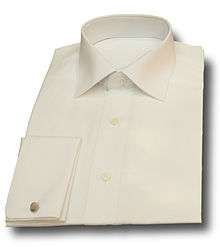
A dress shirt is normally made from woven cloth, and is often accompanied by a tie, jacket, suit, or formalwear, but a dress shirt may also be worn more casually.
In British English, "dress shirt" ("formal shirt" or "tuxedo shirt" in American English) means specifically the more formal evening garment worn with black- or white-tie. Some of these formal shirts have stiff fronts and detachable collars attached with collar studs.
History
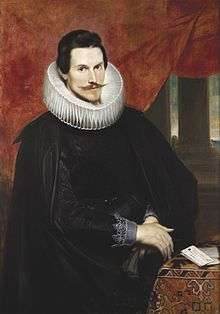
Traditionally dress shirts were worn by men and boys, whereas women and girls often wore blouses or, sometimes, known as chemises. However, in the mid-1800s, they also became an item of women's clothing and are worn by both sexes today.[2]
Components
A shirt has several components: A one-piece back, which is usually pleated, gathered, or eased into a section of fabric in the upper part of the back behind the neck and over the shoulders known as the yoke (either one-piece or seamed vertically in the middle); one-piece sleeves with plackets at the wrist, or else short-sleeved (cut off above the elbow), though this is not traditional; a band of fabric around each wrist known as a cuff; the collar, a strip around the neck, which is normally a turndown collar, with the strip folded down away from the neck, leaving two points at the front, the width of which is known as the spread; and finally two front panels which overlap slightly down the middle on the placket to fasten with buttons (or rarely shirt studs).
Collars
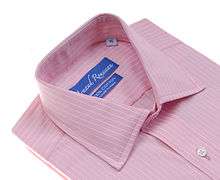
There are various styles of collar, which is the primary indicator of the formality of a shirt.[3] Those discussed here are all attached collars, not styles specific to detachable collars. The very top button is number 1.
- Spread collars measure from around 3 1⁄2 to 8 1⁄2 inches (89 to 216 mm) between the collar points, and the wider collars are often referred to as cutaway or Windsor collars after the Duke of Windsor. This city style is more formal, though it is common in Europe, and predominant in the UK.
- Point, straight, or small collars are narrow, with 2 1⁄2 to 4 inches (64 to 102 mm) between the points of the collar.
- Button-down collars, or "sport collars" have points fastened down by buttons on the front of the shirt. Introduced by Brooks Brothers in 1896, they were patterned after the shirts of polo players and were used exclusively on sports shirts until the 1950s in America. It is still considered a more sporting style, and, particularly outside America, traditionally dressed men still do not wear suits with this style of collar.
The less-common styles below were all once common, but have waned in popularity.
- Eyelet collars require a barbell-style collar bar to join the small stitched hole on each point.
- Tab collars are point collars with two strips of fabric extending from the middle of the collar and joined behind the tie. These lift the tie, giving an arc effect similar to a pinned collar. The tabs can be closed with a metal snap, button or stud.
- Club collars have rounded edges, and were very popular in the first few decades of the twentieth century. They have recently received a surge in popularity due to television shows like Mad Men.
- The varsity is a type of spread collar in which the points curve outward from the placket of the shirt.
- Shirts designed to take a detachable collar have a tunic collar, which is a low standing band of fabric around the neck, with a hole at the front and back for the collar studs.
Contrast collar shirts are occasionally made, which are white collars on a coloured or patterned shirt. These are worn for a variety of reasons, such as to offset certain complexions;[4] because of a tradition started by detachable collars, where it is impractical to have many collars in different matching colours; and finally because when a collar is replaced it is unlikely an exact colour match will be found. These collars are generally considered more formal than matching fabric in shirts that are not white.
Cuffs
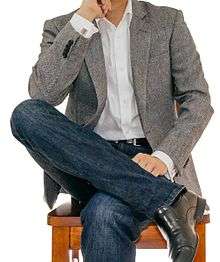
The main distinctions between cuffs are whether they require buttons or cufflinks to fasten, and whether they are folded back (double) or single. The main resulting types are therefore:
- Barrel cuffs, the standard style fastened by one or two buttons according to taste.
- Double, or French cuffs, which are more formal, have an extra length of sleeve folded back and fastened with links.
- Single cuffs, the most formal style, usually only worn with formal eveningwear, are fastened as double cuffs but are without the fold.
In addition, there are some variations, for example barrel cuffs may be mitred, with the corner cut off at 45°. Less common styles include the Portofino, or cocktail cuff, which is a double cuff closed with buttons, first made by the Jermyn Street shirtmakers Turnbull & Asser, and later popularised by the fictional character James Bond in the films from 1962 onwards.
Other features
A high quality traditional shirt has long tails, extending almost to the knees at the back, and so has seven or eight buttons. The vertical strip of fabric running down the front opening is called the placket, and gives a more symmetrical appearance to the joint between the left side, on top, and the right. This left over right order is also seen in waistcoat and coat fastenings, though women's clothing buttons the other way (right over left). The buttonholes, aligned vertically, are placed on the placket, though the top button and buttons at the bottom of stiff fronts are aligned horizontally. The buttonholes are one of the few places where the difference between hand and machine stitching can be observed while the shirt is being worn, and fashion designers sometimes use contrasting thread here or on the buttons themselves for extra impact.
To give extra fullness to the back, there are often pleats where the back panel joins to the yoke. On some fittings these are not needed, and handmade shirts may feature the extra fabric being worked continuously into the seam. In America, a box pleat is common (two pleats together in the centre), while in Britain the pleats are placed wider out under the shoulders.
The less casual shirts in Britain will have no pockets, but the standard shirt in America has a single one on the wearer's left side, which is a sewn-on patch with a plain upper hem, optionally with a single button for closure. This small pocket is large enough to hold a pack of cigarettes or a few pens (a pocket protector can be used). Less formal shirts may feature larger pockets, dual pockets, or pockets with flap closures; safari or other military styled shirts often feature two large pockets with buttoned flaps. Less formal shirts may have small pockets on the sleeves as well. Shoulder straps are virtually non-existent on formal shirts, with the exception of military clothing.
Short-sleeved shirts have a plain (no-button) hem above the wearer's elbow. They are considered a casual summer or tropical option, though many people wear only the traditional long sleeves in all circumstances.
Formal shirts
In the UK, the term dress shirt is reserved for a particular type of formal shirt. There are formal day shirts for wearing with morning dress, and the white dress shirts used as eveningwear.
A day dress shirt is fairly similar to a normal shirt, and is usually white, with a stiff detachable collar, though other designs, such as a vertical blue stripe, are also appropriate. Double cuffs are most common. This sort of shirt is also conventionally worn by some barristers and judges.
An evening shirt, for wear with eveningwear, for example as part of black or white tie has some unique features. In the U.S., this shirt is often called a tuxedo shirt or tux shirt. The shirt is always white.
The shirt required for white tie is very specific. It should have a detachable wing collar and be fastened with shirt studs instead of buttons on the front. The studs are normally mother of pearl set in gold or silver, but black onyx inlay is also permissible. The cufflinks should match the studs. The shirt front has panels made of different material from the rest of the shirt which are the only parts seen under the waistcoat. The shape of the panels, one on each side, is either rectangular, or the older U-shape (designed to sit under the older 1920s U-shaped waistcoats, now largely replaced by the more modern V-shape). The material for the panels is either layers of thick plain cotton that is heavily starched (this type is often called a boiled front shirt as the shirt needs to be put in boiling water to remove the starch before cleaning), or marcella (piqué) cotton. Marcella is more common, but a little less formal, though still appropriate, since it was originally designed to be used on formal evening shirts, as the ribbing can pick up more starch and create an even stiffer front. Traditionally, collarless shirts with a detachable wing collar fastened on with collar studs have been used, but all-in-one designs are occasionally seen, though this is considered incorrect and to give a poor appearance by many.[5][6] Cuffs are single, and heavily starched (if the front is marcella, the cuffs usually match).
Black tie offers more leeway. Shirts may be soft (not starched), which gives the options of unstarched marcella or a pleated front, as well as the white tie shirts, which may also be worn with black tie. The collar is still sometimes a stiff high wing collar (common in America, though the attached variety is more popular there), or a turndown collar (more frequently seen in Britain). In past decades, particularly the 1970s, ruffled shirt fronts were made fashionable by Will Hunter, although they are now out of favour. Dress-studs are optional, and are onyx set in either silver or gold if used; otherwise the buttons are normally concealed under a placket. Cufflinks tend to be as simple and understated as possible, and harmonise with, if not match, the studs.
The placket of the shirt is the part that holds the buttons and the button holes. This is highly regarded as the focal point of the dress shirt when worn casually. Unfortunately due to the lack of reinforcement, the weight of the collar will cripple the placket throughout the day. No amount of starch, ironing, pressing nor does the type of fabric matter when it comes to combating the collapse.
Materials
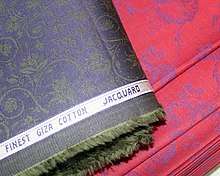
Shirts are made of woven cloth. The natural fibers used more commonly in the past were cotton (the most frequent), linen (the oldest), ramie, wool or silk. Nowadays, artificial fibers, such as polyester or polyester blends, are also used, due to their low cost, despite being considered by most shirtmakers the poorest material, owing to less softness and breathability.[7] However, while high quality cotton shirts can survive with care a few decades, a polyester/cotton blend may be used in more demanding environments. Giza cotton is a type of high-quality cotton which is the preferred choice among high-end shirtmakers, because of its long staple length. Linen produces a cool fabric that wrinkles heavily, and is mostly used in light summer shirts. Cotton is therefore the standard material for all but the cheapest shirts. Silk is occasionally worn, though it is hot to wear and has a marked sheen.
Yarns from these fibers are woven into a variety of different weaves, the most notable of which include broadcloth, with double the number of warp to weft threads, giving a smooth, formal shirting; twill, where the tucks of the weft do not line up, giving a diagonal pattern, a weave used for most country checked (e.g. tattersall) shirtings; poplin, with a heavier warp than weft, giving more formal fabric; and Oxford weaves. Plain Oxford or pinpoint Oxford weaves are popular as casual fabrics, so are generally used in combination with a button-down collar, while royal Oxford is versatile enough to be used on both sporty and formal shirts. There are many other weaves or variations on these, including end-on-end patterns, where alternate white and coloured threads are used, giving a mottled appearance, or more exotic weaves, including voile and batiste, which are extremely light fabrics only used for summer shirts or on the unseen parts of formal shirts.[8]
The use of pattern and colour is also significant. Originally, in the Edwardian era, when the modern shirt emerged, all shirts were white. Gradually more colours were introduced, including blue, the most popular colour, particularly in lighter shades such as Wedgwood. A full range of colours is now commonly available, although white, light blue, cream, and to a lesser extent pale shades of pink and lavender, remain the mainstays of conventional business attire. Less traditional shirts are also made with darker colours, even black. Bright colours and prints for very casual wear were popularised after the War by light holiday clothes such as the Hawaiian shirt.
For more formal business shirts, a plain weave or subtle pattern like herringbone is the norm. In more casual settings, stripes and checkered patterns are common. In more rural areas, plaid or checkered shirts may be more common, such as the tattersall shirts associated with British country clothing. The size of the pattern is meant to coordinate with tweeds of different patterns. Further, the use of colour may be somewhat seasonal, with shades like green being associated more with autumn than summer ones like yellow. Colours and patterns may also be chosen for more than simply aesthetic reasons, as trends such as power dressing (first noted in Molloy, Dress for Success [1975]) emphasise the social impact of clothing. For example, a business executive might stereotypically prefer pinstriped suits and red neckties to project a particular image.
Non-iron
Wrinkle-free shirts have become popular after being first introduced by Brooks Brothers in 1953.[9]
A resin used for making non-wrinkle shirts releases formaldehyde, which could cause contact dermatitis for some people - particularly those who have already developed an allergy; no disclosure requirements exist, and in 2008 the U.S. Government Accountability Office tested formaldehyde in clothing and found that generally the highest levels were in non-wrinkle shirts and pants.[10]
Shirt wearing

A dress shirt is typically ironed to remove any wrinkles and can be treated with starch for added smoothness and stiffness. There are also cotton shirts available in the market which do not require ironing.
The hem is tucked into the trousers. For informal- or formalwear, a coat and tie (or bow tie) are compulsory. When a tie is worn, the top button of the shirt is fastened, so the tie can fit snugly around the wearer's neck with a neat appearance.
When a tie is not worn, conventions on buttoning differ globally: in the United States and the United Kingdom, the top button is virtually never buttoned if a tie is not worn – but unbuttoning two or more buttons is seen as overly casual. In France, unbuttoning two buttons is more common, and politicians appear on TV in this style.
In casual usage, these conventions are often not followed, with many choosing to wear shirts not tucked in, or leaving the top button undone with a tie. This is commonly done by children and young men, particularly as part of school uniform, where it is not allowed. Even more casually, some now choose not to iron their shirts, or use nontraditional 'non-iron' fabrics.
Similarly, as part of more casual work attire, some American men wear shirts with the top two buttons unbuttoned (buttoned at the third button), though buttoning at the fourth button is widely seen as too casual. Accordingly, some shirts are manufactured with a difference at the second or third button, by way of subtle cue as to where to button.[11] Most casually, the shirt can be worn entirely unbuttoned, over a T-shirt.
Fit
In the US, ready-to-wear sizes of dress shirts traditionally consist of two numbers such as 15½ 34, meaning that the shirt has a neck 15 1⁄2 inches (390 mm) in girth (measured from centre of top button to centre of corresponding buttonhole) and a sleeve 34 inches (860 mm) long (measured from midpoint of the back and shoulders to the wrist). However, to reduce the number of sizes needed to be manufactured and stocked, an average sleeve length is sometimes given in the form 15½ 34/35 (indicating a neck 15 1⁄2 inches (390 mm) in girth and a 35 inches (890 mm) sleeve). Since the cuff frequently features two buttons, the cuff diameter can be reduced so that the cuff does not come down over the hand, allowing the shirt to fit the shorter length. Since the sleeve and neck size do not take into account waist size, some shirts are cut wide to accommodate large belly sizes. Shirts cut for flat stomachs are usually labeled, "fitted", "tailored fit" "athletic fit" or "trim fit". The terms for fuller cut shirts are more varied ("Traditional", "Regular" etc.) and are sometimes explained on a shirt maker's website. Additionally, "Portly" or "Big" are often used for neck sizes of 18 inches (460 mm) or more. Very casual button-front shirts are often sized as small, medium, large, and so on. The meaning of these ad-hoc sizes is similarly not standardized and varies between manufacturers.
In the bespoke (custom-made) industry where each shirt is made from an individually drafted pattern, these sizing problems are avoided, though there are still different ways of making the shirt fit. While many choose to cut the sleeve long and have the cuff catch on the hand to regulate its length, some prefer the much harder option of using a high armhole and carefully tailored shape, so that the cuff can be loose and still sit in exactly the right place wherever the arm moves.[12]
Made-to-measure shirts may not fit quite as well as bespoke, but can provide a similar degree of customisation and fit at a lower cost.
For sixty years, US designers and manufacturers of neckties and dress shirts were members of the Men's Dress Furnishings Association but the trade group shut down in 2008 due to declining membership caused by the declining numbers of men wearing neckties.[13]
As part of dress codes
Dress shirts were formerly worn by men most times for nearly all activities. Although they have largely been replaced in recent years by pullover tops such as T-shirts or hoodies as casual wear, they remain overwhelmingly dominant as formal or business attire, and they are almost always expected (or even required where dress codes are enforced) to be worn for such occasions. This tends to apply even when neckties or suit jackets are not, or when even jeans may be worn in lieu of dress pants.
Industrial production
 Dress Shirt finished product
Dress Shirt finished product- Production line
 Sewing operation
Sewing operation- Quality checking
- Fitting checking on dummy
- Dress shirt on conveyor
- Pressing standard
See also
- Shirt
- Shirtdress worn by women
References
- "Definition of BUTTON-DOWN". www.merriam-webster.com. Retrieved 1 April 2018.
- Brough, Dean (April 2013). "The classic white formal shirt : a powerful emblem of social change". 15th Annual IFFTI Conference : The Business & Marketing of Icons.
- Antongiavanni (2002). p. 101
- Flusser (2002). p. 27
- Flusser (2002). pp. 238–239
- Antongiavanni (2006). p. 174
- Antongiavanni (2006). p. 109
- Flusser (2002). pp. 135, 277–305
- Epaminondas, George, "The War Over Non-Iron Shirts" The Wall Street Journal, May 4, 2016.
- When Wrinkle-Free Clothing Also Means Formaldehyde Fumes. New York Times.
- Fashion comes unbuttoned: How low will it go? Archived June 26, 2009, at the Wayback Machine, June 22, 2009, The Seattle Times
- Antongiavanni (2006). p. 106
- Smith, Ray (June 4, 2008). "Tie Association, a Fashion Victim, Calls It Quits as Trends Change". Wall Street Journal. pp. A1. Retrieved 2008-06-07.
Sources
- Antongiavanni, Nicholas (2006). The Suit: A Machiavellian Approach to Men's Style. HarperCollins. ISBN 978-0-06-089186-2.
- Keers, Paul (October 1987). A Gentleman's Wardrobe: Classic Clothes and the Modern Man. Weidenfeld & Nicolson. ISBN 978-0-297-79191-1.
- Flusser, Alan (1985). Clothes and the Man: The Principles of Fine Men's Dress. Villard. ISBN 0-394-54623-7. Retrieved 2008-09-20.
- Flusser, Alan (2002). Dressing the Man: Mastering the Art of Permanent Fashion. HarperCollins. ISBN 0-06-019144-9.